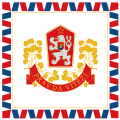 One of the more popular flags used by slovak volunteers during Slovak Uprising 1848. Flags from this period introduced blue color into the slovak flag for the first time, after the Slavic Congress. Used also as flag of Slovak National Council
One of the more popular flags used by slovak volunteers during Slovak Uprising 1848. Flags from this period introduced blue color into the slovak flag for the first time, after the Slavic Congress. Used also as flag of Slovak National Council
(1848–1849) Official flag of the
Official flag of the
Autonomous Slovak land within the Second Czechoslovak Republic
(1938–1939)
First Slovak Republic
(1939–1945)
Slovak Socialist Republic within Czechoslovak Socialist Republic
(1969–1990)
Slovak Republic within Czech and Slovak Federative Republic
(1990–1992)
 | |
| Vlajka neba-vody-ohňa ('Sky-water-fire flag') | |
| Use | National flag |
|---|---|
| Proportion | 2:3 |
| Adopted | 3 September 1992 |
| Design | A horizontal tricolor of white, blue, and red; charged with coat of arms at the hoist side |
| Designed by | Ladislav Čisárik [1] Ladislav Vrtel [1] |
 | |
The current form of the national flag of the Slovak Republic (Slovak : Vlajka Slovenskej republiky) was adopted by Slovakia's Constitution, which came into force on 3 September 1992. The flag of Slovakia, like many other flags of Slavic nations, uses the Pan-Slavic colours (white, blue, and red). Pictured to the left of centre of the flag is Slovakia's national coat of arms.





















